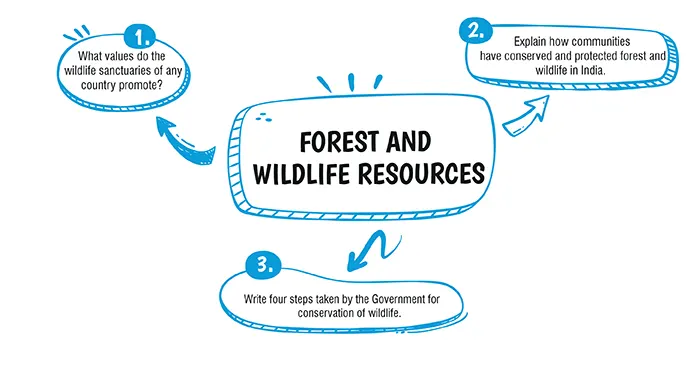Home / Boards / CBSE / Important Questions / Class 10 / Social Science / Forest and wildlife Resources
Table of Contents

Ans. (a)
Explanation:
India receives nearly 4 per cent of the global precipitation and ranks 133 in the world in terms of water availability per person per annum.
Ans. (b)
Explanation:
Of total freshwater, over 68 percent is locked up in ice and glaciers. Another 30 percent of freshwater is in the ground. Rivers are the source of most of the fresh surface water people use.
Explanation:
Wildlife sanctuaries of various country promote the following:
1. Wildlife sanctuaries have been formed to conserve and maintain the diversity and integrity of natural heritage.
2. They help to preserve natural ecosystems.
3. They teach us the value of sharing because we humans along with all living organisms form a complex web of ecological systems in which we are only a part and very much dependent on this system for our own existence.
Explanation:
Role of communities in the conservation of forest and wildlife can be explained as follows:
(i) ‘Sariska Tiger Reserve’ is situated in Rajasthan, here the people of nearby villages have fought against mining activities and protecting the natural habitat of wildlife.
(ii) In Alwar, Rajasthan, the people of five villages have declared 1200 hectares of forest as the “Bhairodev Dakav Sonchuri”. They set their own rules and regulations which do not allow hunting.
(iii) Chipko movement by locals in the Himalayas successfully resisted deforestation.
Explanation:
Five steps that have been taken to protect the wildlife in India are:
1. Under the Indian Wildlife Protection Act 1972, an All India list of protected species was published. The thrust was on protecting the remaining population of certain endangered species by:
(a) Banning hunting.
(b) Giving legal protection to their habitats.
(c) Restricting trade in wildlife.
2. Many wildlife sanctuaries have been developed and National Parks have been set up.
3. Many projects have been started for protecting specific animals which were gravely threatened, e.g. Project Tiger, One-horned Rhino, the Kashmir Stag (hangul), three types of crocodiles —the fresh water, salt-water and Gharials, the Asiatic Lion, etc.
4. Most recently, some animals have been given full or partial legal protection against hunting and trading throughout India, e.g., Indian elephant, black buck, great Indian bustard and the snow leopard, etc.
5. Setting up biosphere reserves for conserving flora and fauna in their natural surroundings and protection of wetland ecosystems is another step taken in this direction.
Download Mind Map of this chapter
Download NowWant to Practice Mock Tests of this chapter
Practice NowDownload Important Questions of this chapter
Download Now| Chapter No. | Chapter Name |
|---|---|
| History | |
| Chapter 1 | The Rise of Nationalism in Europe |
| Chapter 2 | Nationalism in India |
| Chapter 3 | The Making of a Global World |
| Chapter 4 | The Age of Industrialization |
| Chapter 5 | Print Culture and the Modern World |
| Geography | |
| Chapter 6 | Resources and Development |
| Chapter 7 | Forest and Wildlife Resources |
| Chapter 8 | Water Resources |
| Chapter 9 | Agriculture |
| Chapter 10 | Minerals and Energy Resources |
| Chapter 11 | Manufacturing Industries |
| Political Science | |
| Chapter 12 | Power – sharing |
| Chapter 13 | Federalism |
| Chapter 14 | Gender, Religion and Caste |
| Chapter 15 | Political Parties |
| Chapter 16 | Outcomes of Democracy |
| Economics | |
| Chapter 17 | Development |
| Chapter 18 | Sectors of the Indian Economy |
| Chapter 19 | Money and Credit |
| Chapter 20 | Globalization and The Indian Economy |
| Chapter Wise Important Questions for CBSE Board Class 10 Geography |
|---|
| Resources and Development |
| Forest and Wildlife Resources |
| Water Resources |
| Agriculture |
| Minerals and Energy Resources |
| Manufacturing Industries |
CBSE Important Questions Class 10
ICSE Important Questions Class 10
CBSE Important Questions Class 10
ICSE Important Questions Class 10